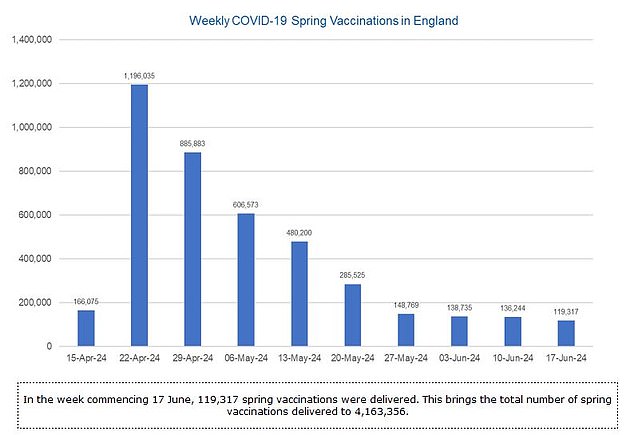Experts have warned Britain could be at the start of a new wave of Covid driven by new ‘FLiRT’ variants and low vaccine uptake.
Hospitals have seen the number of virus cases rise by a quarter in a week due to the more aggressive strains, also known as KP.2 and KP.3, which have already caused a significant increase in cases in the United States.
This is because only 4.1 million of the 7 million vulnerable people eligible for a spring booster dose have taken up the offer, meaning 40 per cent will not get any additional protection.
Experts also fear that current vaccines may be less effective than the FLiRT variants, which have evolved to become more contagious and evade antibodies.
Only 60 percent of those eligible for a spring booster shot have taken it up, leaving around three million vulnerable people with compromised protection.

FLiRT Covid variants have evolved to avoid antibodies created by previous infection and vaccination.

ONS data on Covid infections shows that more than 80 per cent of Britons suffer from a runny nose when infected. Loss of taste or smell, one of the original telltale signs of the virus, accounts for just under a fifth of all symptoms recorded.
Dr Matthew Binnicker, from the Mayo Clinic Clinical Virology Laboratory in the US, said this was because the spike protein – the part that Covid vaccines are designed to target – had changed significantly.
“This variant can evade the immune response more effectively than previous versions of the virus,” he said.
“If you have been infected or vaccinated and have some antibodies in your system, those antibodies may not recognize the protein on the surface of the virus.”
Dr Binnicker added that those who were last vaccinated more than six months ago will have waning immunity and will be more likely to suffer symptoms if they contract Covid.
NHS statistics show the number of people admitted to hospital with Covid rose to 3.31 per 100,000 in the week to June 16, compared with 2.67 per 100,000 in the previous week.
People aged 85 and older made up the largest group of people hospitalised with the virus.
It has become difficult to know how many people nationwide have had the virus as most routine testing has been phased out since the pandemic.
Most of the data recorded today comes from laboratory tests, mostly swabs taken from people in the health care system.
This shows there were 4.37 cases of Covid per 100,000 people admitted to hospital in England on 26 June – around one in every 25,000 people admitted that day..
Professor Paul Hunter, a leading infectious disease expert at the University of East Anglia, said this was a tiny proportion compared with the peak of the pandemic.
He told the BBC that people should not be worried about current Covid rates.
“I think we’re probably seeing as many infections this year as we did last year,” he said.
‘We are all going to suffer repeated Covid infections from birth to death.
‘Overall, what we’ve seen is that over the last three or four years the severity of illness associated with Covid has decreased a lot.
“Eventually, it will become just another cause of the common cold, and for many people, that’s what it is now.”
He added: “To be honest, you can’t really avoid it because it’s so common.”
The FLiRT Covid variants are all descendants of Omicron which became dominant in the UK towards the end of 2021 and beginning of 2022.
They all appear to have acquired the same set of mutations in the spike protein, which the virus uses to attach to humans and gain a foothold.
Some of these mutations make it easier for the virus to infect the nose and throat compared to other circulating variants.
UKHSA epidemiologist Dr Jamie Lopez Bernal said: “If you have symptoms of Covid or flu, help protect others by staying at home and avoiding contact with other people, especially those who are more vulnerable.”
Speaking about the recent rise in cases, Professor Steve Griffin, a medical expert at the University of Leeds, said: ‘It’s clearly early days, but it certainly feels like another wave of Covid is brewing.
“If the rise in hospitalisations continues, it is clearly worrying. Although we have just had a spring booster campaign for vulnerable populations, uptake was lower than in 2023, and there is a considerable gap between current vaccines and circulating viruses.”

